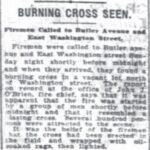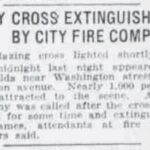Most of the posts that you see here are generally dealing with the history of the Church in the 19th century. Most of them involve the area that now comprises the Archdiocese of Indianapolis. It, of course, does not mean that there is no history of the other parts of the State of Indiana, it just means that most of the material available to us has to do with the southern half of the State.
That being said, I want to move a little into the early 20th century and include not only the southern half of Indiana but the State as a whole, with the emphasis on Indianapolis and Kokomo Indiana.
I want to look at a time when being a Catholic in Indiana could be a dangerous thing. It wasn’t always a big news event and could even come down to individual relationships. For example, I heard of a lady, born in Indianapolis in 1916, who told me once that her childhood playmate told her one day that she could not longer play with her because she was Catholic.
Carrying thea even further, I recommend the book by Timothy Egan, entitled A Fever in the Heartland: The Ku Klux Klan’s Plot to Take Over America, and the Woman Who Stopped Them. The book is a best seller and it deals with the rise and power of the KKK in Indiana.
For many of us, that is ancient history and I think most people who think of the Klan, think about their hatred for African-Americans. But the Klan was also fiercely opposed to Jews and Catholics as well as Blacks.
The “worst” part of that history took place in the early 1920’s. D.C. Stephenson, the “Grand Wizard” of the Klan in Indiana hid his “dark side”, but when that dark side revealed itself, it ended up that Stephenson was convicted of the rape and murder of Madge Oberholtzer, a “neighbor” of Stephenson’s in the Indianapolis suburb of Irvington. Many articles have been written. Here is an excerpt from an article that appeared in the Smithsonian Magazine. It will give you some idea of the evilness of Stephenson.
It was the beginning of the end, in different ways, for both Madge Oberholtzer and D.C. Stephenson, although the politician had long believed himself infallible. “I am the law in Indiana,” he famously declared, and with reason. At age 33, Stephenson was one of the most powerful men in the state, having controlled the governor’s election and the movements of several state legislators, influencing bills on nutrition, steam pollution, fire insurance, highways and even oleomargarine, all of which would line his pockets with graft. His hand-picked candidate for mayor of Indianapolis seemed certain to win election, and Stephenson himself dreamed of running for the U.S. Senate, even president. 1
What does this have to do with Indiana Catholic History? Well, there has always been a story, which came up once again in the Egan book. Egan stated that the Klan burned a “fiery cross” on the property of Our Lady of Lourdes parish in Indianapolis. Egan’s claim was based only on an oral history, located in the Indiana State Library 2
So, did it really happen? Well, it turns out… Maybe
The Klan was fond of their “trademark” burning cross. They would burn a cross in a public area, or on someone’s lawn etc. to let people know that they were in charge, that they and their beliefs were the ‘law”.
Here are three different accounts of what happened. The link will take you to a reminiscent account of a member of the parish, written in 1980. It was, in fact, a “hand-me-down” from his father who is said to have witnessed it. You can view the pages from that article here in the Lourdes Diamond Jubilee pages. 3 Two are from local newspapers, but the location is different in each and neither were actually on Our Lady of Lourdes property. 
 To the left you can see two almost identical clippings — one from the Indianapolis News and the other from the Indianapolis Star. The Indianapolis Times, which was instrumental in the downfall of the KKK had no news of this event since it happened on New Years Eve and the Times did not publish that day or the next.
To the left you can see two almost identical clippings — one from the Indianapolis News and the other from the Indianapolis Star. The Indianapolis Times, which was instrumental in the downfall of the KKK had no news of this event since it happened on New Years Eve and the Times did not publish that day or the next.
So, with the evidence we have, we can say that the KKK did burn a cross in the Irvington district of Indianapolis, but apparently NOT on the property of Our Lady of Lourdes.
So, now we move north, to Kokomo:
On July 4, 1923, Kokomo hosted the largest Ku Klux Klan gathering in history. An estimated 200,000 Klan members and supporters gathered in Malfalfa Park for a massive Konklave in which D. C. Stephenson was elevated to the position of Grand Dragon of the Indiana Klan.
In the summer of 1923, record numbers attended rallies of the Ku Klux Klan in Indiana. On June 16, 1923, a crowd of 75,000 attended a Klan rally in Terre Haute.[60] On June 21 Argos held the largest rally it had ever seen.[61] On June 26 a large Klan rally was held in Alexandria. All of this was merely a prelude to the rally planned for Kokomo. Conceived as a “monster tristate conclave,” it was intended to charter 93 Indiana klans representing more than 300,000 members.[62] Some doubted the prospect of 200,000 attendees, claiming it would be “without parallel in history”;[63] others predicted attendance of 300,000.[64] Extensive preparations for that number were made, including the scheduling of 1,000 interurban cars from around Indiana to Kokomo.[65] The Union Traction Company, in addition to supplying 50 cars, transported three cars of white horses to Kokomo for the parade.[66] The Kokomo Klan rented the fields surrounding its own large lot for parking, and electric amplifiers were obtained to allow the large crowd to hear the speeches.[64]
According to historian Robert Coughlan, “literally half” of Kokomo residents were members of the Ku Klux Klan during its height in the 1920s and 1930s.[67] On July 4, 1923, Kokomo achieved national notoriety when it hosted the largest Ku Klux Klan gathering in history. An estimated 200,000 Klan members and supporters gathered in Malfalfa Park for a massive Konklave in which D. C. Stephenson was elevated to the position of Grand Dragon of the Indiana Klan.[68][69] Other estimates say the crowd was only 10,000.[70] A huge flag was used that day to collect a reported $50,000 for construction of a local “Klan hospital” so that Klan members would not have to be treated at the only local hospital, which was Catholic.[71] Both men’s and women’s Klans held weekly rallies and initiations in Malfalfa Park, and Kokomo’s Klanswomen held meetings at the armory, the local headquarters of the Women of the Ku Klux Klan, and churches. A speech at a Baptist church was attended by 1,000 Klanswomen.[72]
The Kokomo rally sent shockwaves through the national GOP, which had come to believe that the re-election of President Warren G. Harding depended on the vote of Indiana. According to the Washington correspondent of the New York World, Republicans feared that the Klan had “obliterated party lines” and “virtually swallowed” the Indiana Republican Party. Since the Republicans held only a 25,000 vote plurality in the state, any serious defection of African-Americans would tip the state to the Democrats.[73] In the event, Harding died within a month and Republican Calvin Coolidge succeeded him with a substantial electoral majority (including Indiana) against a divided opposition. The Klan, however, continued to dominate state politics especially after the election of Edward L. Jackson as governor. 4
Here, we quote from Egan’s book concerning Kokomo and the Klan:
Robert Coughlan, a ten-year-old boy from a Catholic family, had watched the white-sheeted invaders take over his town, alternately fascinated and frightened. He saw them exchange cryptic, ritualistic greetings and wave at each other with three middle fingers of one hand, that secret salute of the KKK. At day’s end, he was sitting on his front porch when a member of the Klan walked up the steps of a house nearby and plopped into a chair on the veranda. Once the mask was off, the boy could see that the now visible congregant of the Invisible Empire was his neighbor, Mrs. Crousore. Coughlan’s family had been anxiously vigilant for two years, fearing an attack. There were rumors that their pastor at Saint Patrick’s Church would be killed, that the few Jewish merchants would be run out of town by a mob with flaming crosses, that Mr. Coughlan, a Catholic teaching at a public school, would be fired because of his faith. These fears did not take the form of their neighbor, the kindly Mrs. Crousore— until that night. Why, Coughlan wondered later as a writer trying to come to grips with what had happened to his neighbors, “did the town take so whole-heartedly to the Klan?” His answer was rooted in “the deadly tedium of small-town life,” a militant religious fundamentalism “hot with bigotry,” and “American moralistic blood lust that is half historical determinism, and half Freud.” These people needed to hate something smaller than themselves as much as they needed to have faith in something greater than themselves. The Ku Klux Klan “filled a need,” Coughlan concluded, “a need for Kokomo and all the big and little towns that resembled it during the early 1920s.” But then it metastasized. “It first appealed to the ignorant, the slightly unbalanced and the venal,” Coughlan wrote, “but by the time the enlightened elements realized the danger it was already on top of them.” 5
- Taken from Smithsonian Magazine[↩]
- Steers Oral History-ISL[↩]
- Courtesy of the Archives of the Archdiocese of Indianapolis[↩]
- https://en.wikipedia.org/wiki/Kokomo,_Indiana[↩]
- Egan Timothy. 2023. A Fever in the Heartland : The Ku Klux Klan’s Plot to Take Over America and the Woman Who Stopped Them. New York New York: Viking.[↩]